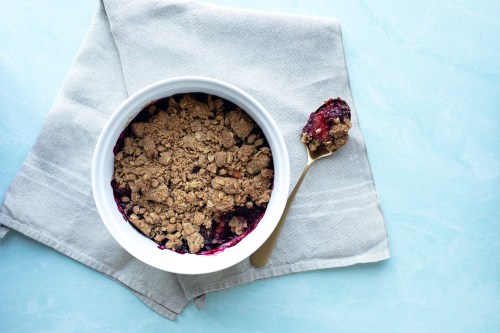No, your mushroom coffee isn’t going to eff with your gut
Do adaptogens help SIBO or other gut issues, or cause it? Here, experts share everything to know about adaptogens for gut health.

Similar to squeezing lemon into a cup of hot water, adding adaptogens to smoothies, coffee, or tea is one of those beverage boosters every in-the-know wellness lover swears by. Hey, any little habit that works to protect your body from stress is worth adopting, right? I know I thought so.
Which is why I was a bit…surprised when I read on Bulletproof founder Dave Asprey’s blog that eating some types of adaptogenic mushrooms could cause flareups of small intestinal bacteria overgrowth (SIBO)—an imbalance of gut bacteria that causes gas, bloating, abdominal pain, diarrhea, and potentially improper nutrient absorption. Um, what?
Suddenly completely freaked out by the reishi next to my favorite coffee cup, I decided to investigate. I turned to Bindiya Gandhi, MD, an integrative health doctor, and Simone Wan, a certified Traditional Chinese Medicine expert and the founder of IN:Total Wellness, for some clarity.
Unpacking the relationship between adaptogens and your gut
The good news: Neither Dr. Gandhi nor Wan say they’ve seen any scientific evidence that adaptogens directly cause SIBO. (Phew!) The condition has numerous other causes, says Dr. Gandhi, including parasites or long-term use of a proton pump inhibitor (PPI) like Prilosec for acid reflux. “Food sensitivities can also lead to SIBO,” she says. “If you are unaware of what you’re sensitive to and you keep consuming it, [it] can then lead to inflammation in the gut.” But so far, adding adaptogens to your coffee is not proven to be one of them.
If your stomach is acting up after introducing adaptogens, something else is likely at play. “If someone is having bloating or abdominal pain because of adaptogens, that may be a sign they are not taking them correctly,” Wan says. “Or, they might have a food sensitivity or allergy. Some people are allergic to fungi and many adaptogens are mushrooms. They might not have made the connection.”
That’s why both experts say it’s best to talk to a pro before adding any adaptogens to your diet. (Which, for the record, is the larger point Asprey was making in his blog post.) “Because adaptogens have several different roles, you want to make sure you’re taking one that’s best for your overall health,” Wan says. “Maca, for example, is great for postmenopausal women. And some adaptogens might not be the best fit for someone who is trying to conceive.” All of this is to say that adaptogens are complicated (and powerful!), so it’s best to get recommendations from someone who spent years studying them.
However, Wan says adaptogens (in conjunction with other treatment) can actually help prevent SIBO. “Stress is a cause of SIBO, and all adaptogens help lower stress by supporting the adrenals,” Wan says. She adds astragalus and dang shen are two herbs in particular that work to strengthen the digestive system. If you’re someone who, when anxious or stressed, starts experiencing some pretty unpleasant tummy troubles, adaptogens could help keep you balanced.
If you have SIBO and your practitioner gives you the green light on adaptogens and mushrooms, be sure to take them with plenty of water. “Adaptogens are plants, and plants have fiber. With SIBO, the digestive system is compromised and it isn’t able to digest food as well, especially high-fiber foods,” Wan explains. “Drinking lots of water can help make the fiber easier to digest.” Instead of adding your adaptogen to a smoothie—which is already loaded with fibrous plants—have it in tea.
Again, adaptogens should not be considered a “cure” for SIBO (or any other condition for that matter). Dr. Gandhi says that if someone is regularly experiencing digestive problems, they should see a doctor first, before getting all fancy with ashwagandha or lion’s mane on their own.
The bottom line: Adding adaptogens to your coffee, tea, or smoothie will not automatically eff up your stomach—but they are powerful herbs that should be handled with care. The key is knowing which adaptogen is best for your individual overall health, which is why you should talk to a pro first before dabbling it them. That way, you can sip that tea with true peace of mind (and peace of gut, too).
TCM herbs are even popping up in your beauty products. After all, they can help fight acne.










